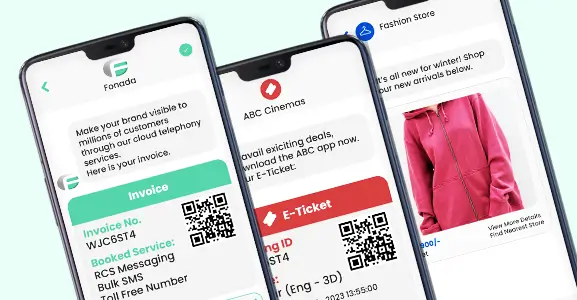Reliable Voice Calling APIs For Businesses
Leverage the programmable voice API to create a distinct calling experience that offers cutting-edge features such as call recording, routing, and analytics.

What Are Programmable Voice Calling APIs?
Programmable Voice Calling APIs are cloud based services provided by communication platforms that enable developers to add real-time voice-calling functionality to their applications. It allows developers to create custom voice communication solutions, such as voice calling, conference calls, voicemail, and more, by providing programmable building blocks for implementing complex voice communication workflows.
With Programmable Voice API, developers can easily integrate voice communication into their applications without needing to manage underlying telephony infrastructure. This API also offers features such as call recording, call analytics, and call routing to create a complete voice communication solution.

Features That Make Fonada’s Calling API Unique
Say it loud, say it clear with our programmable voice API solution

Call And SMS Campaigns
Conduct bulk calling and messaging campaigns with dynamic or static content.

Virtual Number Allocation
Buy, retrieve, assign, and remove virtual numbers dynamically to your call flows.

Click-To-Call
Allow users to initiate calls from your website or app.

Passwordless Authentication
Verify users through missed calls using our patented nOTP product.

Virtual Number Monitoring
Keep track of your Exophones' health and receive real-time alerts when a number goes down.

Cost-Effective Number Mapping
Manage customer conversations with a limited pool of virtual numbers to save costs.


How Do Voice Calling APIs Work?
Stage 01
A developer integrates the Voice Calling API into their application or website.
Stage 02
The developer defines the rules for the voice call, such as when to initiate the call, what message to play, and how to handle user responses.
Stage 03
When a user triggers the voice call through the platform (such as by clicking a button), the API calls the user's phone number or VoIP endpoint.
Stage 04
The user answers the call and hears the predefined message or prompt.
Stage 05
The user can respond by pressing buttons on their phone keypad.
Stage 06
The API processes the user's response and decides how to proceed based on the defined rules.
Stage 07
The API can perform actions based on the user's response, such as sending a confirmation email or updating a database.
Stage 08
The call ends when the predefined call flow is complete, or the user hangs up.
Why Voice Calling APIs For Your Business?
Experience the speed and flexibility within our programmable voice API

Improved Call Management
Calling API can track and monitor calls automatically, providing valuable insights and visibility.

Increased Productivity
By enabling click-to-call functionality within CRM, help desk, and other applications, Click-to-Call API can boost efficiency and streamline workflows.

Enhanced Privacy Protection
Number masking protects the privacy of both callers and callees by concealing their information behind a virtual number.

Empowering Customers
IVR automation and self-service options allow customers to access important information, cancel tickets, and check account balances on their own.

Flexible Call Routing
Programmable voice API allows call flows to be dynamically programmed based on customer input, ensuring calls are routed to the appropriate agent or department.

Use Cases Of Calling API

Benefits Of Using Fonada’s Voice Calling APIs?

Protect The Privacy Of Customers
Number masking protects the caller and callee. A virtual phone number hides the identities of both parties.

Enhance Productivity
Integrate telephony with your helpdesk, CRM, or app using our click-to-call API. Click a button to call without manually dialing.
Call Tracking
We monitor all calls. Our all-details API provides more call visibility.

Platform Independent
Our calling API works efficiently with various platforms, and you can seamlessly integrate API calling in Android or desktop applications.

Dynamic Call Flows
Using input from your customers, programmatically decide call flows. Quickly route calls to the right agent/department.
Why Choose Fonada For Voice Calling APIs?

Reliability
Fonada uses high-quality, reliable infrastructure with its call-handling API to ensure lag-free voice connections for minimized call drops or delays.

Scalability
Our programmable voice API solutions can efficiently handle high volumes of calls, making it suitable for businesses of all sizes.

Customization
We offer flexible programmable calling API solutions that can be customized to meet the unique needs of your business.

Security
We offer a range of measures with our phone call API and follow high-security parameters to protect against fraud, abuse, and other threats.

Excellent Customer Support
We offer excellent customer support as our team of experts is readily available round the clock to help customers with their queries and concerns.

Latest Updates
From Fonada
Industry Insights, Trends, Innovations, Updates, and Case Studies from Industry Experts
View
Customer
Reviews
Discover why our customers love us - read their authentic and heartfelt reviews!
View
Frequently
Asked Questions
Get answers to common queries quickly with our informative Frequently Asked Questions section.
View
Convert Leads Into Sales With Fonada
Trusted CPaaS Solution Provider















